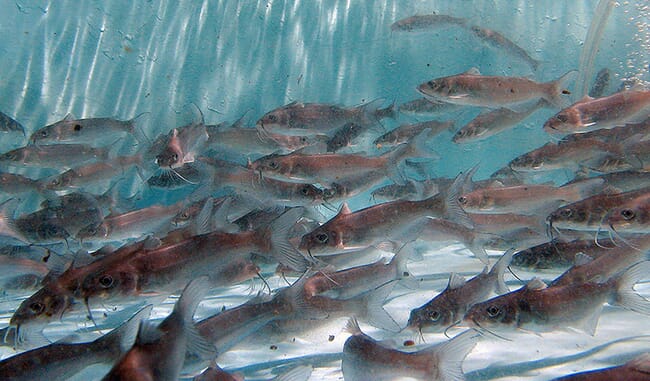A recent paper published in the Web of Conferences journal tracked the progress of Clarias gariepinus, the African sharptooth catfish, during a three-month feed trial, during which some were given Bacillus subtilis and Bacillus licheniformis
probiotics.

© Tom Thompson
The researchers wanted to determine if supplementing aquafeed with probiotics would alleviate some of the biological stress catfish experience in a closed production environment. The team focused specifically on cortisol levels (a hormonal indicator of elevated stress), antioxidant activity and micronuclear images (cellular indicators of stress).
At the conclusion of the trial, the team noted that the catfish who received probiotic-supplemented feed had cortisol levels that were 2.8 times lower than fish in the control group. Catfish in the probiotic group also showed enhanced antioxidant enzyme responses, meaning that they were more resilient to environmental stress. The micronuclear tests showed that fish in the probiotic group sustained 5.7 times less cellular damage in the trial period than their counterparts in the control group.
The study
The researchers kept two cohorts of catfish in a closed water system for the duration of the trail. The first cohort was used as a control group and fed a balanced feed from Coppens. The second cohort received the same feed, supplemented with the probiotic Sporothermin at 4g per kg feed. Sporothermin contains two bacillus subspecies: Bacillus subtilis and Bacillus licheniformis. The bacteria are heat resistant and can withstand acidic environments, making them ideal probiotic candidates for aquaculture.
After the feed trial ended, the researchers took blood and tissue samples to measure the fishes’ cortisol levels, antioxidant enzymes and conduct micronuclear tests.
Why these indicators?
Ideally, producers want to keep fish cortisol levels low – elevated cortisol can negatively impact key metabolic functions like mitosis and can lower finishing meat quality. It is also an indicator of biological stress.
The researchers also focused on antioxidant enzyme levels – specifically catalase and peroxidase. If these are elevated, it means that the fish are better able to protect themselves against oxidative stress and cell damage. It also indicates that the fish are more resilient when faced with environmental pressures or different production conditions.
Micronuclear tests show wear and tear on cells – illustrating the impact the environment has on cell nuclei. Changes in morphology or damage to the nucleus would suggest that the chromosomes inside it had been altered due to the experimental environment.
Results and conclusions
Lab tests indicate that catfish in the control cohort had blood cortisol levels that were 2.8 times higher than catfish fed the probiotic. Peroxidase and catalase levels were significantly lower in the control group – catfish fed the probiotic had antioxidant levels that were 2.7 times higher. The researchers speculate that bacillus probiotics stimulate a strong antioxidant response in the fish, making them more resilient throughout production.
Micronuclear tests showed that catfish in the control group sustained more cell damage over the course of the trial. Sporothermin had a protective effect on cell nuclei. The researchers estimate that catfish fed the probiotic experienced 5.7 times less nuclear damage over the trial.
The researchers concluded that the bacillus subspecies in the probiotic had rebalanced intestinal bacteria in the catfish, which improved their ability to withstand production challenges.



